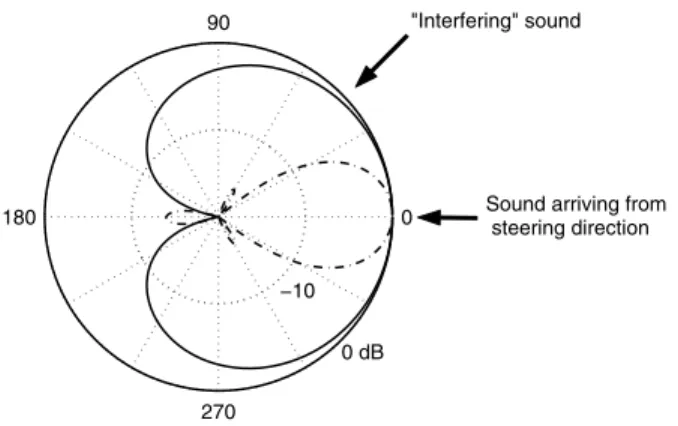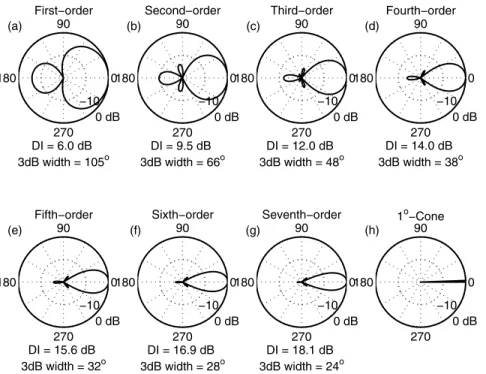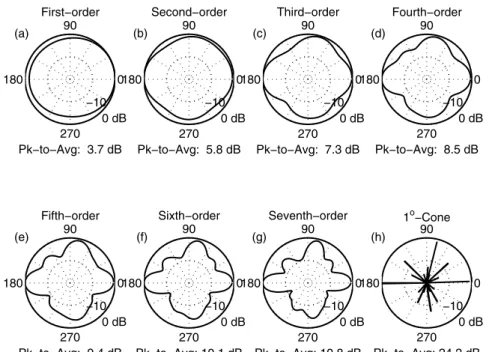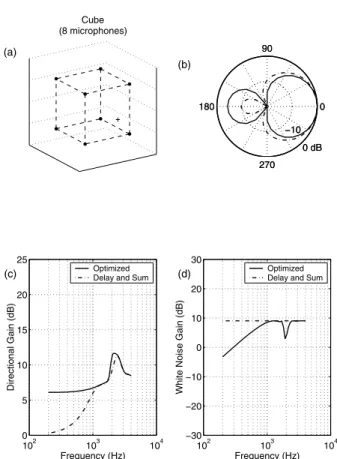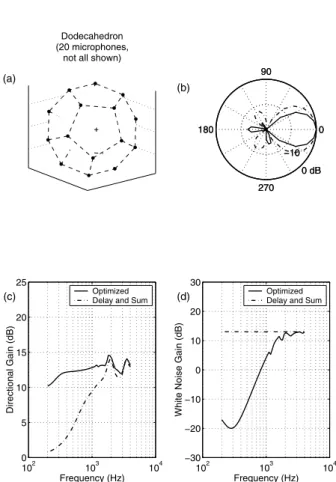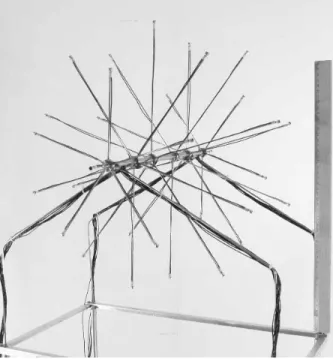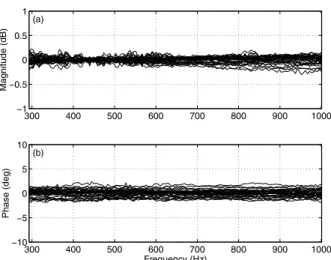Publisher’s version / Version de l'éditeur:
Vous avez des questions? Nous pouvons vous aider. Pour communiquer directement avec un auteur, consultez la première page de la revue dans laquelle son article a été publié afin de trouver ses coordonnées. Si vous n’arrivez pas à les repérer, communiquez avec nous à PublicationsArchive-ArchivesPublications@nrc-cnrc.gc.ca.
Questions? Contact the NRC Publications Archive team at
PublicationsArchive-ArchivesPublications@nrc-cnrc.gc.ca. If you wish to email the authors directly, please see the first page of the publication for their contact information.
https://publications-cnrc.canada.ca/fra/droits
L’accès à ce site Web et l’utilisation de son contenu sont assujettis aux conditions présentées dans le site LISEZ CES CONDITIONS ATTENTIVEMENT AVANT D’UTILISER CE SITE WEB.
Audio Engineering Society 115th Convention [Proceedings], pp. 1-11, 2003-10-01
READ THESE TERMS AND CONDITIONS CAREFULLY BEFORE USING THIS WEBSITE. https://nrc-publications.canada.ca/eng/copyright
NRC Publications Archive Record / Notice des Archives des publications du CNRC :
https://nrc-publications.canada.ca/eng/view/object/?id=c50280c7-e6d7-4fab-9bf7-fce6f6bd5988
https://publications-cnrc.canada.ca/fra/voir/objet/?id=c50280c7-e6d7-4fab-9bf7-fce6f6bd5988
NRC Publications Archive
Archives des publications du CNRC
This publication could be one of several versions: author’s original, accepted manuscript or the publisher’s version. / La version de cette publication peut être l’une des suivantes : la version prépublication de l’auteur, la version acceptée du manuscrit ou la version de l’éditeur.
Access and use of this website and the material on it are subject to the Terms and Conditions set forth at
Designing a spherical microphone array for the directional analysis of
reflections and reverberation
Designing a spherical microphone array for the directional analysis
of reflections and reverberation
Gover, B.N.; Ryan, J.G.; Stinson, M.R.
NRCC-46626
A version of this document is published in / Une version de ce document se trouve dans :
Audio Engineering Society, 115
thConvention, New York, NY.,
Oct. 10-13, 2003, pp. 1-11
Audio Engineering Society
Convention Paper
Presented at the 115th Convention
2003 October 10–13
New York, NY, USA
This convention paper has been reproduced from the author’s advance manuscript, without editing, corrections, or consideration by the Review Board. The AES takes no responsibility for the contents. Additional papers may be obtained by sending request and remittance to Audio Engineering Society, 60 East 42nd Street, New York, New York 10165-2520, USA; also see www.aes.org. All rights reserved. Reproduction of this paper, or any portion thereof, is not permitted without direct permission from the Journal of the Audio Engineering Society.
Designing a spherical microphone array for the directional analysis of
reflections and reverberation
Bradford N. Gover1, James G. Ryan2, and Michael R. Stinson3
1Institute for Research in Construction, National Research Council, Ottawa, Ontario K1A 0R6, Canada 2Gennum Corporation, 232 Herzberg Rd., Kanata, Ontario, K2K 2A1, Canada
3Institute for Microstructural Sciences, National Research Council, Ottawa, Ontario K1A 0R6, Canada
Correspondence should be addressed to Bradford N. Gover (brad.gover@nrc-cnrc.gc.ca)
ABSTRACT
Spherical microphone array designs were investigated from the point of view of suitability for directional analysis of reverberant sound fields. Four array geometries (tetrahedron, cube, dodecahedron, geodesic sphere) were considered. Beamforming filters were designed using a constrained gain maximization process. The theoretical performance of each array was then predicted. A room acoustic simulator was used to help assess sufficient directionality and evaluate the suitability of each design. A 32-element geodesic sphere array was constructed and used to make directional measurements in real sound fields.
1. INTRODUCTION
Measurement of directional information in a sound field is frequently of great interest. “Directional in-formation” is meant to refer to characteristics of the angular distribution of sound passing through
a point. Such information is not readily avail-able through observation of the pressure or intensity alone. The sound pressure is a non-directional mea-sure, whereas intensity is a vector indicating the net direction of energy flow, not necessarily the direction
of arrival of component sound waves. Application areas in which knowledge of directional properties of sound fields could be useful include room acoustic analysis and characterization [1, 2, 3] psychoacous-tic assessment of halls [4, 5, 6, 7], or localization of sources and reflections [8, 9, 10], to name just a few. A straightforward approach at obtaining directional information is to employ a detector that is respon-sive to sounds arriving from one direction only. A directional detector could mean a single directional transducer, a shotgun microphone, a parabolic mi-crophone [1], or a mimi-crophone array [2, 8, 11, 12], for instance. Performance issues (such as angular resolution, bandwidth, fidelity) and practical issues (such as ease of steering in different directions, size, cost) together dictate what type of detector is desir-able.
Beamforming microphone arrays have many favourable properties for directional pickup of sound. They can be designed to yield high direc-tionality, a broad frequency range of operation, and can be steered electronically in many directions simultaneously, without the need for movement of the array. With modern electret microphones and digital acquisition hardware, highly sophisticated arrays can be realized quite inexpensively.
Choice of suitable array geometry is an issue. If the goal is to design a directional detector for analyz-ing sound fields (as in the present work), then in many instances one desirable attribute is spherical symmetry. A spherical array can enable steering an identical beam in any three-dimensional direction. Linear or planar arrays do not.
This paper outlines the steps taken in the design of a spherical microphone array intended for direc-tional analysis of sound fields. A design is selected and constructed, and directional measurements are performed.
2. DIRECTIONALITY REQUIREMENTS
The directional resolution of an array is not infi-nite. The response pattern (beam pattern) usually will have peak sensitivity in the steering direction, with sensitivity rolling off away from this direction. The breadth of this main lobe and steepness of the roll off, as well as the level of any sidelobes all con-tribute to the overall angular discrimination capabil-ities. Two common measures used to quantify this
0 90 180 270 0 dB −10
Sound arriving from steering direction "Interfering" sound
Fig. 1: Illustration of importance of beamwidth for resolving incident sound. The “Interfering” sound will be detected strongly by the cardioid (solid curve), but largely rejected by the fourth-order hypercardioid (broken curve).
are the 3 dB-beamwidth and the directivity index, DI. The 3 dB-beamwidth is the angular width be-tween the half-power points on the main lobe, while the directivity index is the peak-to-average ratio of the beam pattern, expressed in decibels.
The question of how narrow a beam can be realized will be addressed in the next section. This section will address the issue of how narrow a beam is re-quired to obtain useful information from a sound field.
In a free field, the notion of sufficient directionality is easily envisioned. For instance, if two sound waves of interest are incident from two closely-spaced di-rections, to resolve them a beam has to be narrow enough that only one is sensed at a time. That is, the beamwidth must be less than the angular sepa-ration between them. See Fig. 1. In the figure, the first-order cardioid pattern (solid curve) is not nar-row enough to resolve the two arrivals, whereas the fourth-order hypercardioid is. (The term “nth-order hypercardioid” refers to the beam ofnth-order which maximizes the directivity index [13].)
In an enclosure, sound is sure to arrive not only from discrete directions, but eventually from all di-rections. In this case it is not obvious how narrow a beam is necessary to reveal detail in the measured pattern.
GOVER ET AL. SPHERICAL MICROPHONE ARRAY FOR DIRECTIONAL ANALYSIS 0 90 180 270 0 dB −10 DI = 6.0 dB 3dB width = 105o First−order (a) 0 90 180 270 0 dB −10 DI = 9.5 dB 3dB width = 66o Second−order (b) 0 90 180 270 0 dB −10 DI = 12.0 dB 3dB width = 48o Third−order (c) 0 90 180 270 0 dB −10 DI = 14.0 dB 3dB width = 38o Fourth−order (d) 0 90 180 270 0 dB −10 DI = 15.6 dB 3dB width = 32o Fifth−order (e) 0 90 180 270 0 dB −10 DI = 16.9 dB 3dB width = 28o Sixth−order (f) 0 90 180 270 0 dB −10 DI = 18.1 dB 3dB width = 24o Seventh−order (g) 0 90 180 270 0 dB −10 1o−Cone (h)
Fig. 2: Receiver beam patterns used in room simulator: (a)–(g) first 7 orders of hypercardioid, and (h) a 1o-wide cone.
To examine this issue, a method of images room simulator derived from one described in Ref. [14] was used. The receiver in the simulator can be as-signed one of several directivity patterns, and can be steered in any direction. Each image source con-tribution to the impulse response is scaled by the microphone directivity in its direction. In this way, a directional impulse response can be obtained in any number of directions at the receiving position. By computing the energy in each response, the pat-tern of arriving energy with direction is determined. If the beamwidth is too large, the details of the pat-tern will be smoothed out. The limiting case is of a “pencil beam” receiver, which is also simulated for comparison. (Note that the “energy” is not neces-sarily the net acoustic field energy, but rather the energy which would be transported towards the de-tector by a plane wave whose pressure is given by the impulse response.)
The receiver patterns used in the simulator are shown in Fig. 2. Panels (a)–(g) are for the first 7 orders of hypercardioid microphones [13], panel (h) is the pencil beam—a “brick-wall” cone, 1o wide.
Note that there are prohibitive noise and construc-tion issues which make it difficult, if not impossible, at the moment to construct transducers with direc-tivities corresponding to the third-order and higher patterns [13].
Results for the simulation of a small rectangular room are shown in Fig. 3. The plots show the en-ergy arriving at the receiver position, in a plane parallel to the floor. The room had dimensions LX = 4.65 m, LY = 6.70 m, LZ = 2.44 m and had reflection coefficients of 0.75 for each surface. The source was located at (XS = 2.77 m, YS = 4.51 m, ZS = 1.02 m) and the receiver at (XR = 1.58 m,
YR = 4.47 m, ZR = 1.04 m). This arrangement
yields a strong “flutter echo” component propagat-ing back and forth along 0o–180o axis. The direct sound arrival has been removed from the responses. The pattern received with the 1o-cone can be thought of, in a sense, as the “correct answer” (in-sofar as the angular quantization is 1o). The other patterns are basically convolutions of this with the individual beam patterns. Notice that for orders up to about third, no detail to speak of is visible. In AES 115TH CONVENTION, NEW YORK, NY, USA, 2003 OCTOBER 10–13
0 90 180 270 0 dB −10 First−order (a) Pk−to−Avg: 3.7 dB 0 90 180 270 0 dB −10 Second−order (b) Pk−to−Avg: 5.8 dB 0 90 180 270 0 dB −10 Third−order (c) Pk−to−Avg: 7.3 dB 0 90 180 270 0 dB −10 Fourth−order (d) Pk−to−Avg: 8.5 dB 0 90 180 270 0 dB −10 Fifth−order (e) Pk−to−Avg: 9.4 dB 0 90 180 270 0 dB −10 Sixth−order (f) Pk−to−Avg: 10.1 dB 0 90 180 270 0 dB −10 Seventh−order (g) Pk−to−Avg: 10.8 dB 0 90 180 270 0 dB −10 1o−Cone (h) Pk−to−Avg: 24.2 dB
Fig. 3: Simulated received energy patterns for first 7 orders of hypercar-dioid, and 1o-cone receiver. Energy arriving at the receiver position, in a plane parallel to the floor of a simulated rectangular room. The direct arrival has been removed.
the third order and higher patterns, the flutter echo is discernible. Around fourth or fifth order, it ap-pears that detail in the energy arriving between the big peaks emerges. These qualitative statements es-sentially amount to noticing that “more detail is re-solvable with a narrower pattern”, an observation which is supported by the peak-to-average ratios of received energy, indicated in the figure. A higher value indicates a more directional measurement, and it can be seen that the numbers increase as the pat-terns qualitatively appear to contain more detail. There is a “point of diminishing returns”. Above fifth order, the peak-to-average ratio increases only by 0.7 dB per order. The increases per order are larger for the lower orders, up to fourth.
So it seems, (from this one example, at least) that if a design can only achieve second or third-order performance, some information (such as the peak at 135o) will not be discernible. This line of reasoning leads to a beamforming design “target” of directivity index at least 14 dB, beamwidth of at most 38o.
3. BEAMFORMER DESIGN
As mentioned above, to design a beamforming mi-crophone array, both the geometry and the array weights must be determined. Having a design tar-get in mind, proposed designs can be evaluated as to suitability. The process followed herein is exactly that: a geometry is conceived, beamforming weights are designed, and the beamformer performance is predicted and assessed in light of the target.
3.1. Beamforming Procedure
Beamformer design has developed extensively in the past 50 years or so; discussions can be found in text-books such as Ref. [15]. Delay-and-sum designs are simple and robust, but only provide maximum direc-tional gain over a narrow frequency range [16, 17]. Superdirective approaches can achieve higher direc-tional gain over a wider frequency range, but at the expense of simplicity and robustness [13, 18]. The signal-to-noise ratio becomes a problem at low fre-quencies, where the phase change of the sound waves is small over the spatial extent of the array. At higher frequencies, the wavelengths become shorter
GOVER ET AL. SPHERICAL MICROPHONE ARRAY FOR DIRECTIONAL ANALYSIS than the intermicrophone spacing, causing problems
with spatial aliasing. General tradeoffs in achieving higher directionality over a broader frequency range include: tighter required microphone tolerances, less noise immunity, and possibly more difficult construc-tion issues.
The beamformer design procedure used in this work circumvents some of the common noise-induced frequency-restrictive issues to yield a beam which retains a high directionality over a fairly broad frequency range. The procedure is described in Ref. [19], and is outlined in Ref. [12]. It is an op-timized filter-and-sum approach, types of which are discussed in Refs. [18, 20, 21].
For an array with weights w, the directional gain G(ω) at frequency ω is given by
G(ω) = wHRSSw
wHRNNw, (1)
where RSS is the signal correlation matrix, and
RNN is the noise correlation matrix, and the su-perscript H indicates Hermitian transpose. This quantity gives the signal-to-noise improvement us-ing the array, as compared to that usus-ing a sus-ingle microphone.
For spatially-white noise, the noise correlation ma-trix becomes the identity mama-trix, and the expression for the directional gain reduces to
Gw(ω) = w HR
SSw
wHw , (2)
which is the white noise gain. The white noise gain gives a measure of the ability of the array to re-ject uncorrelated noise. High white noise gain means high robustness, and vice versa.
For a given array geometry, it can be seen that the directional gain depends on the microphone signals (determined by steering direction), the noise field, and the array weights. The task is to best select the array weights. Essentially, the present approach assumes a level of noise and microphone mismatch, and incorporates these factors into the estimate of the noise correlation matrix. Then, maximization of the array gain results in a beamformer design which is simultaneously robust and gain-maximized. That is, it is a constrained optimization technique, the constraint being on the white noise gain.
Notwithstanding the details of the design, in the present context, the procedure was used as a “black box” process. Taking a proposed array geometry, steering direction, and microphone mismatch as in-put, the design process outputs the beamforming fil-ters, as well as the directional gain and white noise gain versus frequency. Both of these metrics can be used in assessing the design’s performance.
3.2. Beams for Different Spherical Geometries
Design results for a tetrahedral array (4 micro-phones) are shown in Fig. 4. Those for a cubic array (8 microphones) are shown Fig. 5, and those for a dodecahedral array (20 microphones) are in Fig. 6. These are all regular polyhedra, possessing high de-grees of symmetry. An additional geometry consid-ered is a non-regular polyhedron—a geodesic sphere. The results for a geodesic sphere array (32 micro-phones) are shown in Fig. 7.
Each of Figs. 4–7 has the same layout: Panel (a) shows the geometry of the array. All arrays were designed to have a 10 cm inter-microphone spac-ing; the diameter of the sphere on which the micro-phones lie is not the same across all designs, how-ever. Designing the arrays to have the same in-termicrophone spacing ensures they’ll have similar upper frequency cutoffs (where spatial aliasing be-comes a problem). In all cases the steering direc-tion (indicated by the “+” symbol) is through the centre of one of the faces defining the polyhedron. Different performance will be found by steering the array in different directions. Panel (b) shows the beam pattern at 1 kHz for the optimized design (solid curve) and for a uniformly-weighted (delay-and-sum) beamformer with the same geometry (bro-ken curve). The patterns are shown in the plane containing the centre of the array, the steering di-rection indicated in panel (a), and one of the mi-crophones defining the face through which the array is steered. The steering direction is at 0o. Panel (c) is a plot of the directional gain versus frequency for the optimized design (solid curve) and the delay-and-sum design (broken curve). Panel (d) is a plot of the white noise gain, for the optimized design (solid curve) and the delay-and-sum design (broken curve). Notice that the directional gain curves for the op-timized designs are higher than for the delay-and-sum designs, but that the white noise gain curves AES 115TH CONVENTION, NEW YORK, NY, USA, 2003 OCTOBER 10–13
102 103 104 0 5 10 15 20 25 Frequency (Hz) Directional Gain (dB)
(c) OptimizedDelay and Sum
102 103 104 −30 −20 −10 0 10 20 30 Frequency (Hz)
White Noise Gain (dB)
(d) OptimizedDelay and Sum
Tetrahedron (4 microphones) (a) 0 90 180 270 0 dB −10 0 90 180 270 0 dB −10 (b)
Fig. 4: Tetrahedral array designed assum-ing 0.1 dB sensor noise. (a) Array geometry (sphere diameter 12.2 cm, microphone spac-ing 10 cm), (b) 1 kHz beam pattern for opti-mized design (solid curve) and delay-and-sum design (broken curve), (c) directional gain for optimized design (solid curve) and delay-and-sum design (broken curve), and (d) white noise gain for optimized design (solid curve) and delay-and-sum design (broken curve).
102 103 104 0 5 10 15 20 25 Frequency (Hz) Directional Gain (dB)
(c) OptimizedDelay and Sum
102 103 104 −30 −20 −10 0 10 20 30 Frequency (Hz)
White Noise Gain (dB)
(d) OptimizedDelay and Sum
Cube (8 microphones) (a) 0 90 180 270 0 dB −10 0 90 180 270 0 dB −10 (b)
Fig. 5: Cubic array designed assuming 0.1 dB sensor noise. (a) Array geometry (sphere di-ameter 17.3 cm, microphone spacing 10 cm), (b) 1 kHz beam pattern for optimized design (solid curve) and delay-and-sum design (bro-ken curve), (c) directional gain for optimized design (solid curve) and delay-and-sum de-sign (broken curve), and (d) white noise gain for optimized design (solid curve) and delay-and-sum design (broken curve).
GOVER ET AL. SPHERICAL MICROPHONE ARRAY FOR DIRECTIONAL ANALYSIS 102 103 104 0 5 10 15 20 25 Frequency (Hz) Directional Gain (dB)
(c) OptimizedDelay and Sum
102 103 104 −30 −20 −10 0 10 20 30 Frequency (Hz)
White Noise Gain (dB)
(d) OptimizedDelay and Sum
Dodecahedron (20 microphones,
not all shown)
(a) 0 90 180 270 0 dB −10 0 90 180 270 0 dB −10 (b)
Fig. 6: Dodecahedral array designed assum-ing 0.1 dB sensor noise. (a) Array geometry (sphere diameter 28.0 cm, microphone spac-ing 10 cm) microphones on back half of array not shown, (b) 1 kHz beam pattern for opti-mized design (solid curve) and delay-and-sum design (broken curve), (c) directional gain for optimized design (solid curve) and delay-and-sum design (broken curve), and (d) white noise gain for optimized design (solid curve) and delay-and-sum design (broken curve).
102 103 104 0 5 10 15 20 25 Frequency (Hz) Directional Gain (dB)
(c) OptimizedDelay and Sum
102 103 104 −30 −20 −10 0 10 20 30 Frequency (Hz)
White Noise Gain (dB)
(d) OptimizedDelay and Sum
Geodesic Sphere (32 microphones, not all shown)
(a) 0 90 180 270 0 dB −10 0 90 180 270 0 dB −10 (b)
Fig. 7: Geodesic array designed assuming 0.1 dB sensor noise. (a) Array geometry (sphere diameter 31.2 cm, microphone spac-ings 10 cm and 11.1 cm), microphones on back half of array not shown, (b) 1 kHz beam pattern for optimized design (solid curve) and delay-and-sum design (broken curve), (c) directional gain for optimized design (solid curve) and delay-and-sum design (broken curve), and (d) white noise gain for optimized design (solid curve) and delay-and-sum de-sign (broken curve).
AES 115TH CONVENTION, NEW YORK, NY, USA, 2003 OCTOBER 10–13 7
are lower. Some of the ability of the array to re-ject noise (i.e., robustness) has been traded off in favour of higher directional gain. Also notice that the performance of each array drops off at low fre-quencies, and becomes erratic at high frequencies. These are results of the signal-to-noise problems (at low frequencies) and of spatial aliasing (at high fre-quencies). The notches and dips in the white noise gain curves are presumed to be manifestations of having an incomplete basis from which to form a high-order beam—they can be avoided by adding or moving microphones off the spherical surface or by constructing the array in a rigid body, for instance [22]. Another approach is to smooth the white noise gain curve and perform a second design step using this smoothed curve as a target [12]. This is the approach used in the design described in the next section.
The geodesic sphere array design achieves a direc-tional gain of 14 dB, which is comparable to the target identified above from the simulations.
4. ARRAY CONSTRUCTION
Based on the above, a geodesic sphere array was constructed. The array has a diameter of 48 cm and is intended to operate over the frequency band of 300–1000 Hz. This array is described in Refs. [12, 23], along with a 16 cm similar array designed to operate over 1000–3300 Hz.
A photograph of the 48 cm array is shown in Fig. 8. The stand is constructed from 2.4 mm stainless steel rods, arranged like “spokes” sticking out of a cen-tral shaft. The shaft is supported by 4 thin steel legs, which are used to carry the microphone cables. The microphones are 6 mm omnidirectional electrets (Panasonic WM-61A102B) and are held in place by taping the cables to the spokes. The microphone capsules are not actually touching the stand. The beamforming filters were designed for a micro-phone noise level of 0.1 dB. This was determined by measuring a large number of microphone responses in an anechoic chamber, and selecting a set of 32 that were closely-matched. Figure 9 shows the 32 microphone responses, each normalized by their av-erage and shifted by their mean sensitivities. That is, the plot shows the residual differences in the mi-crophone responses, after applying a gain correction to each. The standard deviation of magnitude is at
Fig. 8: Photograph of 48 cm geodesic spheri-cal array with 50 cm ruler.
worst 0.1 dB and that of phase is at worst 0.5oover 300–1000 Hz.
The beam pattern of the array, computed from the beamforming filters is shown in Fig. 10. The figure shows the average beam pattern over 300–1000 Hz, in the plane containing the centre of the array, the steering direction (through the centre of one of the 60 triangular faces), and one of the microphones bounding that face. The beamwidth is 28o, which is comparable to the sixth-order hypercardioid, al-though the sidelobes are higher (refer to Fig. 2; no-tice the different scales). The pattern is asymmetric since the array is asymmetric in this plane. The response of the array is identical in the directions through the other 59 triangular faces. (These 60 steering directions are 22o or 24o apart.)
5. EXAMPLE MEASUREMENT
The 48 cm geodesic sphere array was used to mea-sure the sound field in a small videoconferencing room. A computer equipped with an 8-channel sound card (Echo Audio Layla24) was used to play a maximum-length-sequence (MLS) over an omnidi-rectional loudspeaker while simultaneously
record-GOVER ET AL. SPHERICAL MICROPHONE ARRAY FOR DIRECTIONAL ANALYSIS 300 400 500 600 700 800 900 1000 −1 −0.5 0 0.5 1 Magnitude (dB) (a) 300 400 500 600 700 800 900 1000 −10 −5 0 5 10 Phase (deg) Frequency (Hz) (b)
Fig. 9: Residual responses of 32 microphones used in construction of geodesic sphere ar-ray (a) magnitude, (b) phase. Microphone responses have been normalized by their av-erage, and shifted by their individual sensi-tivities. 0 30 60 90 120 150 180 210 240 270 300 330 0 dB −20
Fig. 10: 48 cm geodesic spherical array beam pattern in a plane containing the centre of the array, the centre of a triangular face, and one microphone defining this face. This is the average beam pattern over 300–1000 Hz.
0 2 4 6 0 4 8 S A X (m) Y (m) (a) 0 90 180 270 0 dB −10 (b)
Fig. 11: Measurement with 48 cm geodesic spherical array. (a) Top view of room show-ing source position (S), array position (A), a table, and a cabinet. (b) Top view of ar-riving energy integrated over full time decay of room, including direct sound. The direct sound arrival (at 235o) and the reflection from the far wall (at 110o) are evident.
ing 8 of the array microphones. This process was re-peated until all 32 array microphones were sampled, then the microphone recordings were processed to generate a set of 32 omnidirectional room impulse re-sponses. These RIRs were beamformed to generate a set of 60 directional room impulse responses—the response of the array in the 60 steering directions. The level in each steering direction was computed by integrating the directional responses over the full time of decay of the room.
The results are shown in Fig. 11. Panel (a) of the figure shows a top view (plan view) of the room, in-dicating source (S) and array (A) positions. Panel (b) shows a plot of the incident energy at the ar-ray, viewed from the same perspective. The peak sound arrival directions of 235oand 110oagree with the expected direct sound and back wall reflections, computed from the room geometry.
By integrating the impulse responses over differ-ent time windows, or by inspecting them instanta-neously, the temporal evolution of the sound field can be examined. The arrival direction and time of specular reflections can be found. Also, overall as-sessments of the diffuseness or isotropy can be made. More detailed discussions of measurements made with this array are described in Refs. [12, 23, 24].
6. CONCLUSIONS
Spherical microphone arrays are well-suited to anal-ysis of directional information in sound fields. Pow-AES 115TH CONVENTION, NEW YORK, NY, USA, 2003 OCTOBER 10–13
erful computers and inexpensive microphones and sound cards are making it possible to realize sophis-ticated arrays, so frequently the problem comes back to design. A design approach of defining require-ments, selecting candidate geometries and beam-former design procedures, then evaluating the de-signs was used to arrive at a 32-element geodesic sphere array. After careful selection of microphones, the array was constructed and used for room acous-tical measurements. Directions of important sound incidence were easily identified in a small room. In areas such as room acoustic characterization or di-agnosis, source and reflection detection, leak detec-tion, flanking path identificadetec-tion, and diffuse field assumption validation, it is anticipated that direc-tional arrays can be quite useful.
7. ACKNOWLEDGMENTS
BNG would like to thank Dr. John Vanderkooy at the University of Waterloo (Ontario, Canada) for many useful technical discussions, and for financial support.
8. REFERENCES
[1] R. Thiele, “Richtungsverteilung und Zeitfolge der Schallr¨uckwurfe in R¨aumen,” Acustica 3, 291–302 (1953).
[2] A.D. Broadhurst, “An acoustic telescope for ar-chitectural acoustic measurements,” Acustica
46, 299–310 (1980).
[3] H. Tachibana, Y. Yamasaki, M. Morimoto, Y. Hirasawa, A. Maekawa, and C. P¨osselt, “Acous-tic survey of auditoriums in Europe and Japan,” J. Acoust. Soc. Jpn. (E), 10, 73–85 (1989). [4] A. Abdou and R.W. Guy, “Spatial
informa-tion of sound fields for room-acoustics evalu-ation and diagnosis,” J. Acoust. Soc. Am. 100, 3215–3226 (1996).
[5] H. Okubo, M. Otani, R. Ikezawa, S. Komiyama, and K. Nakabayashi, “A system for measuring the directional room acoustical parameters,” Appl. Acoust. 62, 203–215 (2001).
[6] T. Peltonen, T. Lokki, B. Gouatarb`es, J. Meri-maa, and M. Karjalainen, “A system for multi-channel and binaural room response measure-ments,” Convention Paper 5289, Presented at
the 110th Convention of the Audio Engineering Society, Amsterdam, 12–15 May (2001). [7] J. Merimaa, T. Lokki, T. Peltonen, and M.
Kar-jalainen, “Measurement, analysis, and visual-ization of directional room responses,” Conven-tion Paper 5449, Presented at the 111th Con-vention of the Audio Engineering Society, New York, 21–24 September (2001).
[8] W. T¨ager and Y. Mahieux, “Reverberant sound field analysis using a microphone array,” Pro-ceedings ICASSP-97, IEEE International Con-ference of Acoustics, Speech, and Signal Pro-cessing, Munich, Germany, April (1997). [9] J.S. Abel and D.R. Begault, “Methods for room
acoustic analysis using a monopole-dipole mi-crophone array,” Proceedings InterNoise98, Pa-per 123. International Congress on Noise Con-trol Engineering, Christchurch, New Zealand, November (1998).
[10] D.I. Havelock, G.A. Daigle, and B.N. Gover, “Localization of noise source and primary re-flections in a room using a spherical array and aggregate beamforming technique,” Paper N275, Presented at Inter-Noise2003, Seogwipo, Korea, 25–28 August (2003).
[11] T. Nishi, “Development of a multi-beam array microphone for multi-channel pickup of sound fields,” Acustica 76, 163–172 (1992).
[12] B.N. Gover, J.G. Ryan, and M.R. Stinson, “Mi-crophone array measurement system for analy-sis of directional and spatial variations of sound fields,” J. Acoust. Soc. Am. 112, 1980–1991 (2002).
[13] G.W. Elko, “Superdirectional Microphone Ar-rays,” Chapter 10 of Acoustic Signal Processing for Telecommunication, edited by S.L. Gay and J. Benesty (Kluwer Academic, Norwell, MA, 2000).
[14] J.B. Allen and D.A. Berkley, “Image method for efficiently simulating small-room acoustics,” J. Acoust. Soc. Am. 65, 943–950 (1979).
[15] D.H. Johnson and D.E. Dudgeon, Array Sig-nal Processing: Concepts and Techniques, (Prentice-Hall, Englewood Cliffs, NJ, 1993).
GOVER ET AL. SPHERICAL MICROPHONE ARRAY FOR DIRECTIONAL ANALYSIS [16] J.L. Flanagan, “Use of acoustic filtering to
con-trol the beamwidth of steered microphone ar-rays,” J. Acoust. Soc. Am., 78, 423–428 (1985). [17] G.W. Elko, “Microphone array systems for hands-free telecommunication,” Speech Com-munication, 20, 229–240 (1996).
[18] D.K. Cheng, “Optimization techniques for an-tenna arrays,” Proc. IEEE, 59, 1664–1674 (1971).
[19] M.R. Stinson and J.G. Ryan, “Microphone ar-ray diffracting structure,” Canadian Patent Ap-plication CA-2292357 (1999). Available on-line at http://patents1.ic.gc.ca
[20] H. Cox, R.M. Zeskind, and M.M Owen, “Ro-bust adaptive beamforming,” IEEE Trans. ASSP, 35, 1365–1376 (1987).
[21] J.G. Ryan and R.A. Goubran, “Optimum near-field performance of microphone arrays sub-ject to a far-field beampattern constraint,” J. Acoust. Soc. Am., 108, 2248–2255 (2000). [22] J. Meyer, “Beamforming for a circular
micro-phone array mounted on spherically shaped objects,” J. Acoust. Soc. Am., 109, 185–193 (2001).
[23] B.N. Gover, “Development and use of a spher-ical microphone array for measurement of spa-tial properties of reverberant sound fields,” Ph.D. thesis, Department of Physics, Univer-sity of Waterloo, Waterloo, Canada (2001). [24] B.N. Gover, J.G. Ryan, and M.R. Stinson,
“Measurements of directional properties of re-verberant sound fields in rooms using a spheri-cal microphone array,” submitted to J. Acoust. Soc. Am. (2003).
AES 115TH CONVENTION, NEW YORK, NY, USA, 2003 OCTOBER 10–13 11
